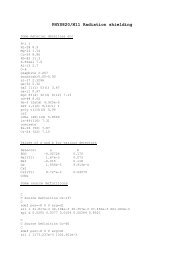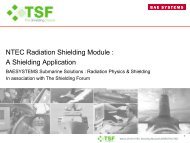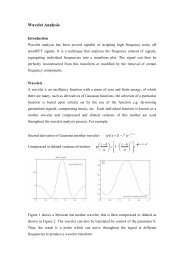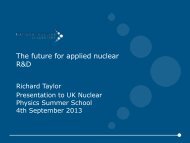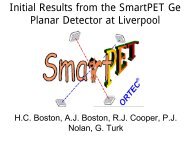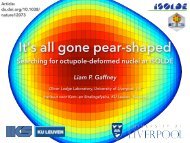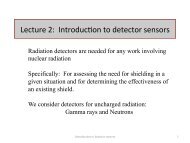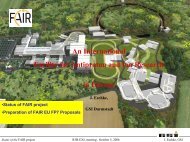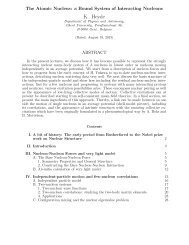Nuclear Astrophysics - Nuclear Physics
Nuclear Astrophysics - Nuclear Physics
Nuclear Astrophysics - Nuclear Physics
You also want an ePaper? Increase the reach of your titles
YUMPU automatically turns print PDFs into web optimized ePapers that Google loves.
<strong>Nuclear</strong> <strong>Astrophysics</strong><br />
• energy generation in stars<br />
• nucleosynthesis (primordial + stellar)<br />
www.cyc.ucl.ac.be/CARINA<br />
a mengoni for CARINA
Why are radioactive ion beams<br />
needed in astrophysics?<br />
average interaction time:<br />
(half-life of X by interaction with Y )<br />
τ ( X ) =<br />
y<br />
N<br />
y<br />
1<br />
σ v<br />
• Hydrostatic equilibrium: quiescent burning stages in stellar evolution<br />
example p+p: T ~ 15x10 6 K, ρ=100 g/cm 3 ⇒ average interaction time τ ~ 10 9 y<br />
additional example >><br />
• Explosive scenarios<br />
T > 10 8 K, ρ>10 3 g/cm 3 (ex: WD surface) ⇒ average interaction time τ ~ sec<br />
www.cyc.ucl.ac.be/CARINA<br />
a mengoni for CARINA
Explosive burning - astrophysical sites<br />
<br />
In explosive astrophysical sites such as the binary systems novae and X-ray bursters,<br />
nucleosynthesis [ up to A ~ 60 (nova) and A ~ 80 – 100 (X-ray burst) ] is thought to be provided<br />
by hydrogen and helium burning at high temperatures and densities. [J José et al. (1999), H Schatz et<br />
al., (1998) ]<br />
snapshots of a classical Nova outburst (courtesy of J José)<br />
<br />
<br />
<br />
Hydrogen and helium rich material from a companion aging main sequence star piles up onto<br />
the surface of a white dwarf (WD in nova) or neutron star (NS in X-ray burst) forming an<br />
accretion disk.<br />
The temperature and density increase in the surface of the WD (T>10 8 K, ρ>10 3 g/cm 3 ) or NS<br />
(T>10 9 K, ρ>10 6 g/cm 3 ) generating a sudden increase of the star luminosity.<br />
Critical T and ρ values: reactions involving H and He on nuclei ranging from C to Ca releasing<br />
energy in a runaway thermonuclear explosion.<br />
www.cyc.ucl.ac.be/CARINA<br />
Source: Carmen Angulo (CARINA)
Novae & HCNO breakouts<br />
(exact path depends on given stellar conditions)<br />
26 Si<br />
27 Si 28 Si<br />
30<br />
P(p,γ) 31 S<br />
heavy nuclei<br />
beyond S<br />
25<br />
Al(p,γ) 26 Si<br />
24 Al<br />
25 Al<br />
26 Al<br />
27 Al<br />
rp-process<br />
onset<br />
21 Mg 22 Mg<br />
23 Mg<br />
24 Mg 25 Mg<br />
26 Mg<br />
18<br />
F(p,α) 15 O<br />
17<br />
O(p,α) 14 N<br />
breakout<br />
from HCNO<br />
20 Na<br />
18 Ne 19 Ne<br />
20 Ne<br />
21 Na 22 Na<br />
23 Na<br />
21 Ne 22 Ne<br />
NeNa<br />
cycle<br />
17<br />
O(p,γ) 18 F<br />
17<br />
F 18 F<br />
19 F<br />
14<br />
O<br />
15<br />
O<br />
16 O 17 O 18 O<br />
(α,p)<br />
(p,γ)<br />
(α,γ)<br />
HCNO<br />
13 N 14 N<br />
15<br />
N<br />
(p,α)<br />
(β + )<br />
stable<br />
12 C<br />
13<br />
C<br />
unstable<br />
www.cyc.ucl.ac.be/CARINA<br />
a mengoni for CARINA
Novae nucleosynthesis<br />
18<br />
F(p,α) 15 O<br />
25<br />
Al(p,γ) 26 Si<br />
30<br />
P(p,γ) 31 S<br />
17<br />
O(p,γ) 18 F<br />
17<br />
O(p,α) 14 N …etc.<br />
18 F: 10m 25 Al: 7.2s 30 P: 2.5m<br />
Beams<br />
Beam intensity<br />
Energy range<br />
Targets<br />
Instrumentation<br />
requesters<br />
: 18 F, 25 Al, 30 P, 17 O<br />
: more than 10 9 pps<br />
: below 500 keV (CM)<br />
: foils (problem of stability for high beam currents?);<br />
gas targets needed?<br />
: detectors, recoil separator<br />
: Jordi José, Alain Coc<br />
Examples of CARINA list of key-reactions<br />
www.cyc.ucl.ac.be/CARINA<br />
a mengoni for CARINA
ack to explosions<br />
www.cyc.ucl.ac.be/CARINA<br />
a mengoni for CARINA
Nucleosynthesis<br />
Mixing<br />
(abundance distribution)<br />
Big-Bang & H-burning<br />
interstellar<br />
gas & dust<br />
He burning<br />
C-O burning<br />
Si burning<br />
ejection, explosion<br />
condensation<br />
x-process<br />
N=50<br />
r s<br />
NEUTRONS<br />
N=82 N=126<br />
r<br />
s<br />
s<br />
r<br />
p-process<br />
<strong>Nuclear</strong> reactions:<br />
• energy generation<br />
• nucleosynthesis<br />
alberto.mengoni@cern.ch
Nucleosynthesis beyond Fe<br />
process<br />
conditions<br />
timescale<br />
site<br />
s-process<br />
(n,γ)<br />
β-decay<br />
...<br />
T~ 0.1 GK<br />
τ n ~ 1-1000 yr, n n ~10 7-8 /cm 3<br />
10 2 yr<br />
10 5-6 yrs<br />
Massive stars (weak)<br />
Low-mass AGB stars (main)<br />
r-process<br />
(n,γ)<br />
β-decay<br />
β-delayed n-emission<br />
fission<br />
...<br />
T~1-2 GK<br />
τ n ~ μs, n n ~10 24 /cm 3<br />
< 1s<br />
Type II Supernovae ?<br />
Neutron Star Mergers ?<br />
www.cyc.ucl.ac.be/CARINA<br />
a mengoni for CARINA
The r-process r<br />
path<br />
www.cyc.ucl.ac.be/CARINA<br />
a mengoni for CARINA
The canonical r-process<br />
(n,γ) ↔ (γ,n) time-reversal invariance (detailed balance) leads to:<br />
log<br />
λ<br />
λ<br />
n,<br />
γ<br />
γ , n<br />
≈<br />
log<br />
N n<br />
−<br />
34.07<br />
−<br />
3<br />
2<br />
log<br />
A<br />
T<br />
A + 1<br />
9<br />
+<br />
5.04<br />
T<br />
9<br />
Q(<br />
Z,<br />
A<br />
+ 1)<br />
for example:<br />
λ γ,n ~ λ n,γ for Q n ~ 2 MeV (usual definition of “r-process path”)<br />
under the condition: N n = 10 24 cm -3 and T = T 9<br />
needs masses & β-decay rates of neutron-rich rich nuclei<br />
along the r-process r<br />
path<br />
D D Clayton, “Principle of stellar evolutions and nucleosynthesis”, U of Chicago Press, 1968, pag. 584 (Problem 7-30).
Endpoint of the r-processr<br />
r-process ended<br />
by n-induced n<br />
fission<br />
or spontaneous<br />
fission<br />
(different paths for<br />
different conditions)<br />
Goriely & Clerbaux A&A 348 (1999), 798<br />
Source: H Schatz (MSU)<br />
Consequences:<br />
- modification of the A~130 r-process r<br />
abundance peak<br />
- fission products can be seed for additional r-processing r<br />
up to A~250<br />
fission again<br />
fission recycling
Role of β-delayed n-emissionn<br />
Neutron rich nuclei can emit one or more neutrons during β-decay if S n<br />
Effects:<br />
during r-processr<br />
process: none as neutrons get recaptured quickly<br />
during freezeout: modification of final abundance<br />
late time neutron production (those get recaptured)<br />
Calculated r-process production of elements (Kratz et al. ApJ 403 (1993) 216):<br />
before β-decay<br />
after β-decay<br />
smoothing effect from β-delayed n emission !<br />
Source: H Schatz (MSU)
Example: impact of P n for<br />
for<br />
137 Sb<br />
Cs (55)<br />
Xe (54)<br />
I (53)<br />
Te (52)<br />
Sb (51)<br />
Sn (50)<br />
In (49)<br />
Cd (48)<br />
Ag (47)<br />
Cs131<br />
> 99<br />
Cs132<br />
> 99<br />
Cs133 Cs134<br />
> 99<br />
Cs135 Cs136<br />
19.00<br />
Cs137<br />
> 99<br />
Cs138<br />
> 99<br />
Cs139<br />
> 99<br />
Cs140<br />
63.70<br />
Cs141<br />
24.94<br />
Cs142<br />
1.70<br />
Cs143<br />
1.78<br />
Cs144<br />
1.01<br />
Cs145<br />
0.59<br />
Cs146<br />
0.32<br />
Cs147<br />
0.23<br />
Xe130 Xe131 Xe132 Xe133 Xe134 Xe135 Xe136 Xe137 Xe138 Xe139 Xe140 Xe141 Xe142 Xe143 Xe144 Xe145 Xe146<br />
> 99 > 99 > 99 > 99P n 39.68 =0% 13.60 1.73 1.24 0.30 1.15 0.90<br />
I129 I130<br />
> 99<br />
I131<br />
> 99<br />
I132<br />
> 99<br />
I133<br />
> 99<br />
I134<br />
> 99<br />
I135<br />
> 99<br />
I136<br />
83.40<br />
I137<br />
24.50<br />
I138<br />
6.49<br />
I139<br />
2.28<br />
I140<br />
0.86<br />
I141<br />
0.43<br />
I142 I143 I144 I145<br />
Te128 Te129 Te130 Te131 Te132 Te133 Te134 Te135 Te136 Te137 Te138 Te139 Te140 Te141 Te142 Te143 Te144<br />
> 99 > 99 > 99 > 99 > 99 19.00 17.50 2.49 1.40<br />
Sb127 Sb128 Sb129 Sb130 Sb131 Sb132<br />
PSb133<br />
n =99.9%<br />
Sb134 Sb135 Sb136 Sb137 Sb138 Sb139 Sb140 Sb141 Sb142 Sb143<br />
> 99 > 99 > 99 > 99 > 99 > 99 > 99 1.66 0.82<br />
Sn126<br />
> 99<br />
Sn127<br />
> 99<br />
Sn128<br />
> 99<br />
Sn129<br />
> 99<br />
Sn130<br />
> 99<br />
Sn131<br />
56.00<br />
Sn132<br />
39.70<br />
Sn133<br />
1.20<br />
Sn134<br />
1.12<br />
Sn135 Sn136 Sn137 Sn138 Sn139 Sn140 Sn141 Sn142<br />
In125<br />
2.36<br />
In126<br />
1.60<br />
In127<br />
1.09<br />
In128<br />
0.84<br />
In129<br />
0.61<br />
In130<br />
0.26<br />
In131<br />
0.28<br />
In132<br />
0.20<br />
In133<br />
0.18<br />
In134 In135 In136 In137 In138 In139 In140 In141<br />
Cd124 Cd125 Cd126 Cd127 Cd128 Cd129 Cd130 Cd131 Cd132 Cd133 Cd134 Cd135 Cd136 Cd138 Cd139 Cd140<br />
10 1<br />
1.24 0.65 0.51 0.43 0.34 0.27 0.20<br />
A=136<br />
Ag123 Ag124 Ag125 Ag126 Ag127 Ag128 Ag129 Ag130 Ag131 Ag132 Ag133 Ag135 Ag136 Ag137 Ag138 Ag139<br />
0.29 0.17 0.16 0.10 0.11 0.06 0.05<br />
( 99%)<br />
76 77 78 79 80 81 82 83 84 85 86 87 88 89 90 91 92<br />
Source: H Schatz (MSU)<br />
abundance (per 10 6 Si)<br />
10 0<br />
10 -1<br />
10 -2<br />
r-process<br />
r-process<br />
waiting<br />
waiting<br />
point<br />
point<br />
Pn=0%<br />
solar<br />
Pn=99%<br />
A=137<br />
( 0%)<br />
r-process<br />
waiting point<br />
125 130 135 140 145<br />
mass number A
Summary: nuclear physics for the r-processr<br />
S n<br />
, M<br />
T 1/2<br />
P n<br />
fission<br />
G<br />
N A<br />
<br />
quantity<br />
neutron separation energy, mass<br />
β-decay half-lives<br />
β-delayed n-emission branchings<br />
branchings and products<br />
partition functions<br />
neutron capture rates<br />
effect<br />
path<br />
abundance pattern<br />
timescale<br />
final abundance pattern<br />
endpoint<br />
abundance pattern?<br />
degree of fission cycling<br />
path (very weakly)<br />
final abundance pattern during freezeout?<br />
conditions for waiting point approximation<br />
a mengoni for CARINA
Experimental quests & tools<br />
• Ground-state properties & spectroscopy<br />
masses, β-decay rates, spectra<br />
• Resonance properties<br />
elastic, inelastic scattering<br />
transfer reactions<br />
• Capture reactions<br />
resonant & direct capture<br />
Coulomb dissociation<br />
indirect methods (ANC, THM, etc.)<br />
www.cyc.ucl.ac.be/CARINA<br />
a mengoni for CARINA
Main goals of the CARINA (*) network<br />
‣ To carry out mapping studies of the European situation in terms of projects, facilities and<br />
teams in order to identify the available instrumentation and human potential.<br />
‣ To develop the research capabilities of existing Large Scale Facilities (LSF) and of smaller<br />
laboratories and enhance involvement in the future RIB facilities.<br />
‣ To record the needs for new instrumentation and techniques; look for existing “solutions” in<br />
other fields.<br />
‣ To coordinate research efforts by defining and proposing common research goals and by<br />
encouraging new collaborations and new R&D projects.<br />
(*)<br />
CARINA: Challenges and Advanced Research in <strong>Nuclear</strong> <strong>Astrophysics</strong><br />
Date of beginning: 1 January 2005<br />
Date of end: 31 December 2008<br />
Budget: 35 k€<br />
Co-ordinator: Carmen Angulo (CRC, Louvain-la-Neuve)
CARINA Tasks<br />
Task 1: Setup activity<br />
Four working groups have been established (January 2005):<br />
1. "Theory" - nuclear and astrophysical models<br />
Conveners: Alain Coc (CSNSM) / Jordi José (Barcelona)<br />
2. "Instrumentation"<br />
Conveners : Tom Davinson (Edinburgh) / Giacomo de Angelis (INFN LNL)<br />
3. “Link to the EURONS_LSF”<br />
Conveners : Alberto Mengoni (CERN) / Klaus Sümmerer (GSI)<br />
4. “Link to non-EURONS_LSF labs working on nuclear astrophysics”<br />
Conveners : Michael Heil (KFZ Karlsruhe) / Endre Somorjai (ATOMKI)<br />
Task 2: link to EURONS, organization of workshops, website, reports, etc.<br />
www.cyc.ucl.ac.be/CARINA<br />
Source: Carmen Angulo (CARINA)
N-02 CARINA activities in 2006<br />
• Mapping studies of laboratories and experimental groups<br />
(done, see annex to annual report 2005)<br />
– Working group 3 (Klaus Suemmerer / Alberto Mengoni)<br />
– Working group 4 (Michael Heil / Endre Somorjai)<br />
• Mapping studies of theoretical groups<br />
– Working group 1 (Alain Coc / Jordi José)<br />
– Contact of groups working on:<br />
• Astrophysical models (and observations)<br />
• <strong>Nuclear</strong> theory for astrophysical applications<br />
– Extended list, more than 25 additional groups<br />
• Already positive (and enthusiastic) answers received<br />
www.cyc.ucl.ac.be/CARINA<br />
Source: Carmen Angulo (CARINA)
N-02 CARINA activities in 2006<br />
• Survey of key reactions and instrumentation<br />
– Identification of astrophysical sites<br />
• Explosive burning – 80% done<br />
• AGB’s stars – 50 % done<br />
• s-, p-, and r-process – just started<br />
• Work mainly done by e-mail<br />
• Discussions to take place during “Nuclei in the Cosmos IX”<br />
at CERN, Geneva, June 25-30, 2006<br />
Additional SC meeting by the end of 2006<br />
www.cyc.ucl.ac.be/CARINA<br />
Source: Carmen Angulo (CARINA)
N-02 CARINA activities in 2006<br />
• Workshop on data compilations in Basel (June 23-25)<br />
– Goal:<br />
• Basic need in all astrophysical modeling to have access to the best<br />
available and most consistent input data.<br />
• Bring together (experimental and theoretical) data providers,<br />
experienced experts on an unbiased analysis, and the modelers who are<br />
in urgent need of utilizing the best available data input<br />
– Scientific contribution from CARINA (advisory committee)<br />
– No financial contribution (thanks to JINA!)<br />
Need of involvement on international scientific activities:<br />
collaborative work<br />
www.cyc.ucl.ac.be/CARINA<br />
Source: Carmen Angulo (CARINA)
N-02 CARINA activities in 2006<br />
• EURISOL: subtask « astrophysics »<br />
– Invited talk at the EURISOL meeting in Trento, January 2006.<br />
– Request from EURISOL task 10 leader to coordinate the subtask<br />
“astrophysics”<br />
• Acceptance as this involves the CARINA community: similar interests,<br />
work effectively.<br />
• Meeting at Pisa, April 10-12<br />
All documents produced by CARINA<br />
are available on the website:<br />
www.cyc.ucl.ac.be/CARINA<br />
Source: Carmen Angulo (CARINA)
Instrumentation for nuclear astrophysics<br />
A survey of instrumentation available in present-day laboratories active in<br />
experimental nuclear astrophysics suggests the following required devices:<br />
‣ Gas targets (recirculation for rare gases; continuous luminosity monitoring)<br />
‣ A multi-stage fusion-product recoil separator (high leak-beam suppression, high rate<br />
focal plane detectors)<br />
‣ A high-resolution magnetic forward spectrometer (high rate focal plane detectors)<br />
‣ Large-area, fine-granularity solid-state detectors or telescopes (on sharing basis;<br />
standard electronics and DAQ systems)<br />
‣ A dedicated high-resolution, high-efficiency gamma-ray detection system<br />
The “flagship” ISOL type facility must have these tools<br />
available for the nuclear astrophysics community<br />
www.cyc.ucl.ac.be/CARINA<br />
Source: Carmen Angulo (CARINA)
Some additional key reactions<br />
18<br />
F(p,α) 15 O<br />
<br />
The competition between the 18 F(p,α) 15 O and the 18 F β-decay has consequences regarding a<br />
possible observation of the 511 keV γ-ray from novae (ex. INTEGRAL): γ-rays from novae<br />
have not been detected yet.<br />
‣ Several experiments already performed…<br />
17<br />
O(p,γ) 18 F , 17 O(p,α) 14 N<br />
<br />
<br />
17 O (and perhaps 19 F): galactic chemical evolution; it is believed that 17 O on earth or in our<br />
bodies was made in novae<br />
C, N, O elemental abundances are observed in emission spectra of nova ejecta; isotopic<br />
ratios 12 C/ 13 C and 14 N/ 15 N are observed in pre-solar grains that originated from nova<br />
explosions<br />
‣ Recent experiments at LENA @ NC (Iliadis, Champagne et al.); CSNSM @ Orsay<br />
(Tatischeff et al.)<br />
Source: Carmen Angulo (CARINA)
Some additional key reactions<br />
14<br />
O(α,p) 17 F<br />
<br />
The reaction is thought to play an important role in advanced stages of hydrogen burning,<br />
either as: a way of bypassing the slow positron decay of 14 O (t 1/2 = 70.6 s) in the hot CNO cycle<br />
or as a starting point to break out the cycle through the subsequent 17 F(p,γ) 18 Ne(α,p) 21 Na<br />
reactions.<br />
‣ Recent experiment at RIKEN; project at LLN<br />
15<br />
O(α,γ) 19 Ne<br />
<br />
<br />
One of the main breakout reaction from the hot CNO cycle.<br />
No direct measurement ever performed:<br />
‣ Very low cross section: very intense 15 O beam needed (< 10 12 pps)<br />
‣ Presently, 15 O beam intensity is ~ 10 7 pps.<br />
Source: Carmen Angulo (CARINA)
Some additional key reactions<br />
22<br />
Na(p,γ) 23 Mg<br />
<br />
Peak fluxes for the 1275 keV γ-ray line ( 22 Na decay) might be detectable by near future γ-ray<br />
satellites (i.e. INTEGRAL) if an ONe nova explodes within a distance of less than ~ 0.5 kpc.<br />
30<br />
P(p,γ) 31 Si<br />
<br />
<strong>Nuclear</strong> activity in the Si-Ca region is powered by a leakage from the NeNa-MgAl region,<br />
where the activity is confined during the early stages of the outburst. This is the main<br />
reaction that drives nuclear activity towards heavier species beyond S.<br />
‣ Uncertainties affecting 30 P(p,γ) 31 S influence Si yields (relevant for the identification of<br />
presolar nova candidate grains) and the nuclear activity beyond S (J. José, 2004)<br />
Source: Carmen Angulo (CARINA)
The end
Example:<br />
3 He + 3 He → 4 He + 2p<br />
T ~ 15x10 6 K (e.g. our Sun) ⇒ kT ~ 1 keV<br />
E 0 ~ 20 KeV<br />
σ ( E)<br />
=<br />
1<br />
E<br />
e<br />
−2πη<br />
S(<br />
E)<br />
Example:<br />
3 He + 3 He → 4 He + 2p<br />
T ~ 15x10 6 K (e.g. our Sun) ⇒ kT ~ 1 keV<br />
E 0 ~ 20 KeV<br />




